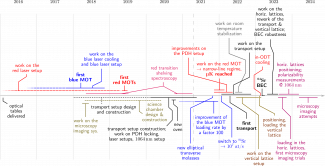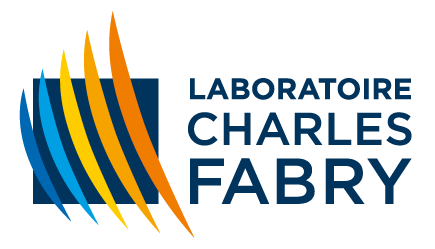Dynamique quantique
Membres
Permanent.e.s
- Marc Cheneau
- Florence Nogrette
Doctorant.e.s
- Félix Faisant (2021-)
- Sanghyeop Lee (2023-)
- Arnab Maity (2024-)
Recherche
Statistical mechanics, a century-old theory, is probably one of the most powerful constructions of physics. It predicts that the equilibrium properties of any system composed of a large number of particles depend only on a handful of macroscopic parameters, no matter how the particles exactly interact with each other. But the question of how many-body systems relax towards such equilibrium states remains largely unsolved. This problem is especially acute for quantum systems, which evolve in a much larger mathematical space than the classical space-time and obey non-local equations of motion. Quantum relaxation dynamics is a flourishing research topic that has undergone a paradigm change in the past decade thanks to brilliant theoretical advances. Yet experimental evidence for the new paradigm remains scarce, which prevents the topic to reach full maturity.
Our team focuses its research precisely on the dynamics of quantum gases, which serve here as a model system for generic many-body quantum systems. We are currently building a new platform to perform our experiments. The atomic species we have chosen is Strontium, which offers both bosonic and fermionic isotopes and features a versatile optical spectrum with broad, narrow and ultra-narrow lines. The atoms will be confined to a two-dimensional geometry, and subject to an optical lattice. Our set-up will implement a fluorescence microscopy imaging system enabling single-atom sensitive, single-site resolved in-situ detection of the atoms. The ability to excite the atoms to a Rydberg state shall complete our tool set for tailoring the microscopic parameters of our model system.
Our first scientific objective will be to test the universality of the 'quasi-particle scenario' put forward to explain the propagation of correlations in a quantum system brought far from equilibrium by a so-called 'quantum quench'. According to this scenario, the first times of the dynamics consists in the emission of quasi-particle excitations which then propagate across the system and spread the correlations which exist between them. It follows that something analogous to a light-cone ‑meaning a well-defined space-time region in which correlations can develop‑ should emerge and bound the dynamics. Such scenario has been numerically observed in a number of configurations, but experiments are required where numerics fails.
Dernières nouvelles

Publications
Articles
- Romaric Journet, Félix Faisant, Sanghyeop Lee, Marc Cheneau. Differential polarizability of the strontium intercombination transition at 1064.7 nm. Physical Review A, 2024, 110 (3), pp.032819 – lien éditeur – lien arXiv
- Marc Cheneau. Experimental tests of Lieb–Robinson bounds. The Physics and Mathematics of Elliott Lieb, 1 (1), EMS Press, pp.225-245, 2022 – lien éditeur – lien arXiv
- I Manai, A Molineri, C Fréjaville, C Duval, P Bataille, et al.. Shelving spectroscopy of the strontium intercombination line. Journal of Physics B: Atomic, Molecular and Optical Physics, 2020, 53 (8), pp.085005 – lien éditeur – lien arXiv
Thèses
- Romaric Journet, Progress towards fluorescence microscopy imaging of a Strontium quantum gas, 2023 – lien HAL
- Clémence Briosne-Fréjaville, Transport et confinement optique d'atomes de strontium pour une expérience de microscope à gaz quantique, 2020 – lien HAL
- Anaïs Molineri, Un nouveau dispositif pour étudier la relaxation d'un système quantique à N corps, 2019 – lien HAL
Anciens membres de l'équipe
Doctorant.e.s
- Romaric Journet (2019-2023)
- Clémence Briosne-Fréjaville (2017-2021)
- Anaïs Molineri (2016-2020)
Postdoctorant.e.s
- Sayali Shevate (2021)
Stagiaires
- Mona Ghazal
- Charline Roux
- Erwan Le Doeuff
- Matthieu Cassus
- Gonzague de Tanoüarn
- Noémie Marquet
- Fabian Finger
- Alice Fontbonne
- Annie Pichery
Financements
- Université Paris Saclay (Graduate School de physique)
- DIM QuanTiP – Quantum Technologies in Paris Region
- LabEx PALM
- European Research Council (ERC) under the European Union's Horizon 2020 research and innovation programme (grant agreement number 679408 / DYNAMIQS)
- European Union's Horizon 2020 research and innovation programme (H2020-FETPROACT-2014 grant number 640378 / RYSQ)
- International Balzan Prize Foundation, par l'intermédiaire du prix attribué à Alain Aspect en 2013
